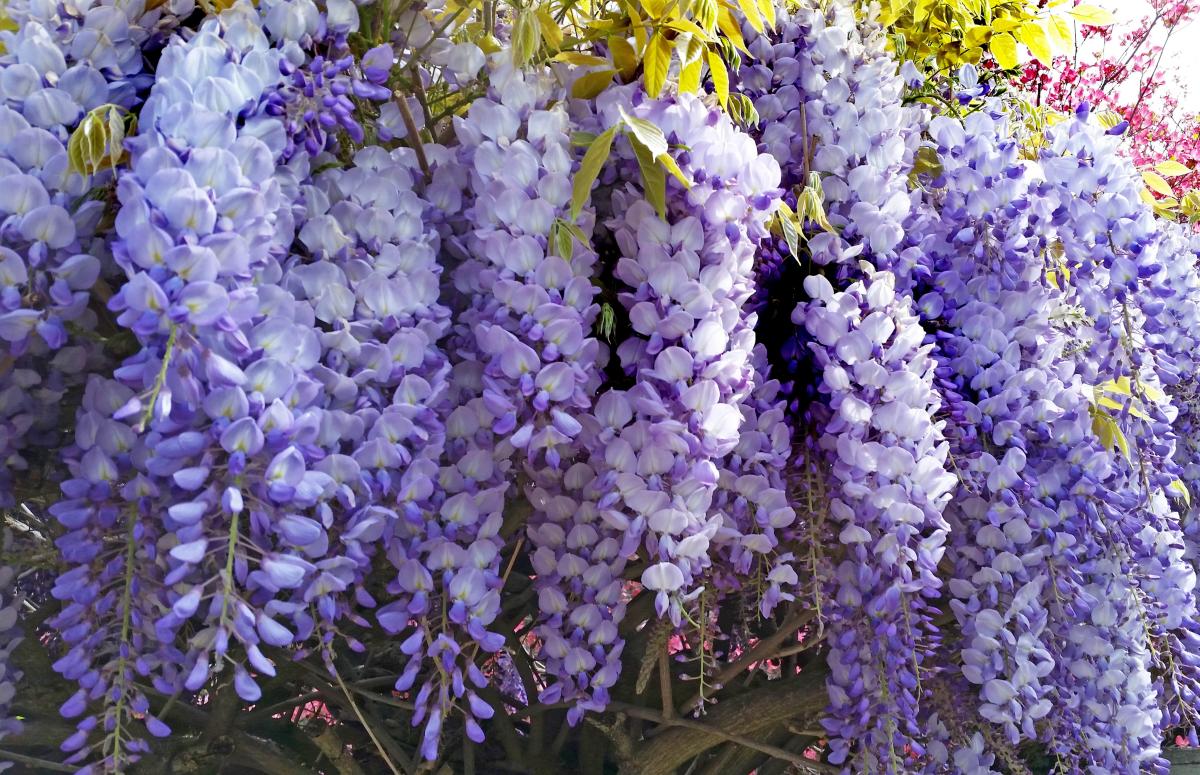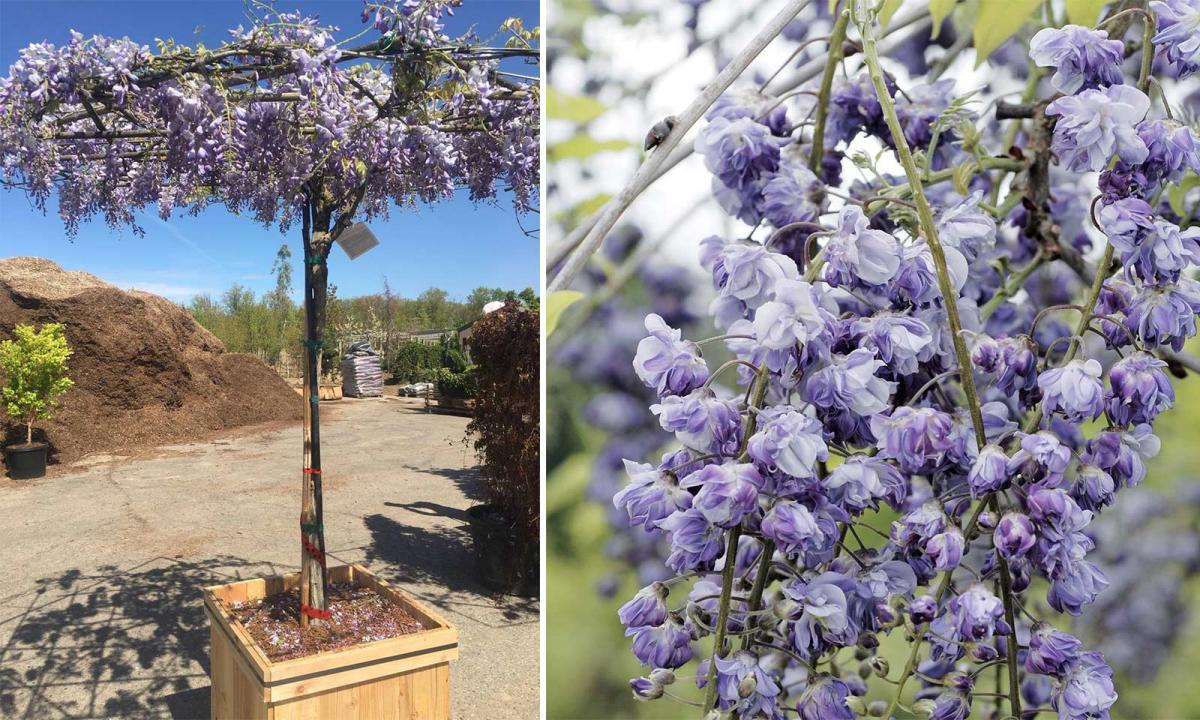
If the wisteria or wisteria is characterized in something, it is in being a large, very large climbing plant. Of all the ornamental vines that are marketed, she is one of the largest once she reaches adulthood.. And we are talking about that it can be 20 meters high if it has support, and extend another 10 meters laterally.
But there are many of us who have fallen in love with it, with its pinnate leaves and its clusters of lilac or white flowers. And the truth is that, even if we don't have a garden or the soil is not adequate, yes it is possible to have a potted wisteria, as long as we give it some care.
Sun or shade?
It is a plant that grows best if the leaves are exposed to the sun and the trunk is shaded / semi-shaded. In addition, it is important that it is outside, since inside the house it could not live long.
It resists frost very well, in fact it tolerates up to -30ºCAnd the heat of up to 40ºC does not feel bad either if you have water, so we will not have to worry about that.
What pot should it have?
Not only does wisteria grow fast, it also has a fairly large root system. Therefore, even if you buy a seedling that measures no more than 1 meter, feel free to plant it in a large pot.
I myself planted one that at that time was 40 centimeters high and was nothing more than a thin stick with leaves in a container about 30 centimeters in diameter, and after a few months it was already over a meter in height.
As for the material, don't worry. The ideal is to plant it in a clay one as it resists the passage of time very well; but actually if you plant it in a plastic one it will also be fine. Of course, it is highly recommended that it be a suitable pot to be outdoors, since they last longer than those that are not because the plastic is harder.
Regardless of the pot you buy, make sure it has holes in its base so the water can come out. Wisteria does not like to have waterlogged roots.
Is it to be transplanted?
If we consider that it is a large plant that grows fast, from time to time we will have to change the pot. This will be done if we see that the roots come out of the drainage holes. The right time for this is late winter or early spring.
What soil / substrate do I put on it?
It is a plant that grows on acid or slightly acid soils, that is, they are poor in calcium, and have a low pH (between 4 and 6). This is very important to know because if we plant it in alkaline soils (pH higher than 6), its leaves will become chlorotic due to the lack of iron. Why? Because iron, even if it is present in the soil, when its pH is very high, it remains blocked, inaccessible to the roots.
And that is something that acid plants, like wisteria, are very harmful. You need the iron to be able to perform the photosynthesis normally, and when it is scarce, the leaves lose clorofila and they turn yellow, leaving only the green nerves. Therefore, one way to avoid it is plant it in specific substrates for acid plants (on sale here). Another option is to plant it in coconut fiber (for sale here), which is also acidic.
How and when to water potted wisteria?

The first thing to know is that, since it is an acid plant, if we water it with water whose pH is higher than 6, what we will achieve is that it becomes chlorotic and that, consequently, it begins to lose leaves due to lack of iron. In addition, even if it is in a substrate for acidic plants, if we water it with a water that does not have a low pH, sooner or later the pH of the soil will end up rising. Because, the best we can do is water with rainwater, or if that is not possible, check the pH with a meter like this.
If it is high, we can lower it with vinegar or lemon. But be careful: you have to add a small amount, since it would not be good if it fell below 4. In fact, you have to measure the pH every time you add vinegar or lemon.
Once we have the irrigation water ready, we must know that wisteria does not resist drought. During the summer you have to water frequently, and more if you live like me in a region where the sun's rays hit the ground with force. And it is that when a high degree of insolation + high temperatures is combined, the need to hydrate is also very high, whether you are plant or animal.
Therefore, you have to water your potted wisteria three or even four times a week. If one day you find it with fallen stems or branches (as if they were hanging) but it has green leaves, that is because it lacks water. Yes indeed: never wet the leaves, and less if at that moment the sun hits them, since they would burn.
The rest of the year the frequency of irrigation will be lower. Temperatures are usually cooler, and it can rain more. So we will water once or twice a week.
Does it have to be paid?
It is convenient, yes. We want it to be healthy, but also to flourish when it can. For this reason, it is highly recommended to fertilize it throughout its growing season, that is, from spring to late summer.
We will use fertilizers or liquid fertilizers, specific for acid plants (for sale here), or with guano (for sale here) which is natural. If we follow the instructions specified on the package, we will be able to have a beautiful wisteria, for sure.
How is it pruned?

Image - Gardenplantsonline.co.uk
To have a potted wisteria throughout its life there is no other option than to prune it every year. For that, it must be done either at the end of winter if it is a young specimen (a thin stick with leaves), or in autumn if the trunk has already started to thicken. This is so because wisteria blooms in spring, and of course, if we can get a fairly adult specimen in late winter, it probably won't produce flowers that year.
How do you prune it? Well, first you have to know what tools to use:
- Household scissors for thin green stems.
- Anvil scissors for branches that are about 1 centimeter thick.
- Small hand saw for branches 2 centimeters or more thick.
- Healing for thick branches.
Once we have it we will disinfect the tools with soap and water, and we will proceed to prune the wisteria. First of all, we must decide if we want to have it as a shrub or tree, or as a small climber, since we will not prune the same.
Wisteria like shrub / sapling
If we are interested in having it as a tree or shrub, we have to leave the trunk bare, with a more or less rounded crown. With that image in mind, we can start working.
- To get the trunk to be more or less straight, we will put a tutor on it and tie it to it with zip ties.
- Now we will eliminate the branches that are sprouting from the lower part from the trunk.
- Then, we will proceed to trim the branches that are growing a lot, with two purposes: one, to shape the crown; and two, so that they branch more.
- Finally, we will proceed to seal the wounds of the thick branches with healing paste.
Wisteria as a climber
In the event that we want it to climb a not very large lattice or arch, we will simply have to guide it where we want it to climb, for example with a tutor. Later, It will only be a matter of trimming those branches that are growing a lot.
If we want it to branch more than it does, we will cut the branches a bit. Thus we will force them to do so, ensuring that the support that is climbing is hidden before.
By following these tips, you are probably going to enjoy growing a potted wisteria for a long, long time.
